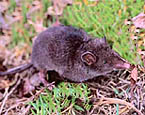|
Incan
Caenolestid
(Lestoros inca) #69-89 |
||||
|
|
Physical
characteristics and distribution
|
|
Breeding season is believed to be early July, as specimens trapped
in August were suckling young. |
|
Description
of the brain
|
|
The brain weight is .745 g (includes R. Trg.). The brain meaurements are: Length AP left 8.9 mm; Length AP right 9.0 mm; Bitemporal width 11.7 mm; Temporal height left 7.6 mm; Temporal height right 8.1 mm. |
|
Animal
source and preparation
|
|
All
specimens collected followed the same preparation
and histological procedure.
|
Other
Related Resources (websites and publications)



